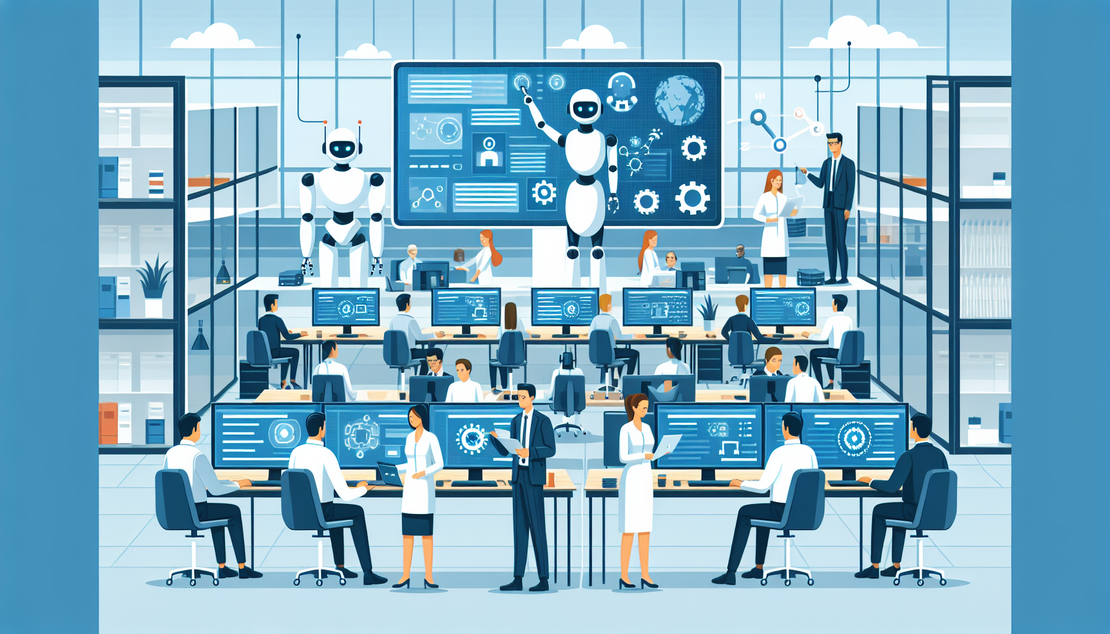
The Impact of AIoT on Business Automation: Enhancing Operational Efficiency
- Rajdeep Barad
- Aio t , Business automation , Operational efficiency , Ai applications
- January 5, 2025
The Impact of AIoT on Business Automation: Enhancing Operational Efficiency
Introduction to AIoT and Business Automation
Artificial Intelligence of Things (AIoT) represents the integration of artificial intelligence (AI) technologies with Internet of Things (IoT) infrastructure to enhance business automation processes. AIoT leverages the power of AI to make IoT devices smarter and more efficient, enabling businesses to streamline operations and drive innovation.
Pro Tip: AIoT is not just about devices; it’s about leveraging intelligent data processing to make informed decisions and automate tasks.
The Role of AIoT in Enhancing Operational Efficiency
1. Real-time data analysis and decision-making: AIoT enables businesses to gather real-time data from connected devices and use AI algorithms to analyze this data swiftly. This allows for proactive decision-making and agile responses to changing conditions.
Pro Tip: Implement machine learning algorithms in AIoT systems to continuously improve data analysis accuracy over time.
2. Predictive maintenance and reducing downtime: AIoT can predict equipment failures before they occur by analyzing historical data and performance patterns. This proactive approach minimizes downtime and lowers maintenance costs.
Pro Tip: Integrate AIoT sensors into machinery to monitor performance metrics and detect anomalies early on, preventing costly breakdowns.
3. Supply chain optimization through AIoT insights: By utilizing AIoT data analytics, businesses can optimize inventory levels, automate replenishment processes, and enhance overall supply chain efficiency.
Pro Tip: Use AIoT predictive analytics to forecast demand fluctuations and adjust inventory levels accordingly, reducing stockouts and excess inventory.
4. Improved customer experience with personalized services: AIoT enables businesses to collect and analyze customer data to offer personalized product recommendations, tailored services, and seamless experiences. This personalized touch enhances customer satisfaction and loyalty.
Implementing AIoT Solutions in Business Automation
1. Assessing the current operational processes for AIoT integration: Before adopting AIoT solutions, businesses should conduct a thorough assessment of existing operational workflows to identify areas that can benefit from automation and AI-driven insights.
Pro Tip: Start small with pilot AIoT projects to test feasibility and assess the impact on operational efficiency before scaling up across the organization.
2. Selecting the right AIoT devices and platforms for business needs: It’s essential to choose AIoT devices and platforms that align with the business objectives, scalability requirements, and compatibility with existing systems.
Pro Tip: Look for AIoT solutions that offer seamless integration with cloud services for secure data storage and accessibility from anywhere.
3. Establishing data security and privacy measures: As AIoT involves handling massive amounts of sensitive data, businesses must prioritize data security protocols, encryption methods, and privacy compliance to protect valuable information from cyber threats.
Pro Tip: Implement multi-layered cybersecurity measures, including encryption, access controls, and regular security audits, to safeguard AIoT infrastructure from potential vulnerabilities.
4. Training employees for AIoT adoption: To successfully integrate AIoT into business operations, organizations need to invest in training programs to upskill employees and ensure they understand how to leverage AIoT technologies effectively.
Case Studies: Successful Integration of AIoT in Business Automation
1. Smart manufacturing processes: Companies like Siemens have integrated AIoT systems to optimize manufacturing workflows, monitor equipment performance in real-time, and enable predictive maintenance, leading to reduced downtime and increased operational efficiency.
2. AIoT for inventory management: Retail giants like Amazon utilize AIoT solutions to track inventory levels, automate order fulfillment processes, and forecast demand trends accurately, resulting in improved inventory turnover and reduced carrying costs.
3. Enhancing customer engagement through AIoT: Organizations like Starbucks leverage AIoT technologies to personalize customer interactions, offer targeted promotions, and enhance the overall in-store experience, driving customer loyalty and satisfaction.
Challenges and Considerations in Adopting AIoT for Business Automation
1. Data privacy and security concerns: Protecting sensitive business data from unauthorized access, data breaches, and cyber threats remains a critical challenge for organizations implementing AIoT solutions.
Pro Tip: Encrypt AIoT data both in transit and at rest to ensure end-to-end security and compliance with data protection regulations like GDPR.
2. Integration complexities with existing systems: Integrating AIoT into legacy infrastructure can be complex and require interoperability solutions to ensure seamless connectivity and data exchange between disparate systems.
Pro Tip: Utilize API-based integrations and middleware solutions to bridge the gap between AIoT applications and legacy systems, facilitating data sharing and interoperability.
3. Cost implications of AIoT implementation: Deploying AIoT solutions involves initial investment costs for hardware, software, training, and maintenance, which can be a barrier for small and medium-sized enterprises with limited budgets.
4. Scalability and future-proofing AIoT solutions: Businesses need to consider scalability factors when implementing AIoT to accommodate growth, technological advancements, and evolving business requirements.
Future Trends in AIoT and Business Automation
1. Evolution of AIoT technologies: The future of AIoT is likely to witness advancements in machine learning algorithms, edge computing capabilities, and AI-driven IoT analytics for even more intelligent and autonomous systems.
2. Industry-specific applications of AIoT: Various industries, such as healthcare, agriculture, and transportation, will continue to explore industry-specific AIoT applications to optimize processes, improve decision-making, and deliver enhanced services.
3. Collaborative ecosystems for AIoT innovation: Collaborations between AIoT solution providers, technology partners, and industry experts will drive innovation, foster knowledge-sharing, and accelerate the development of next-generation AIoT solutions.
4. The role of AIoT in shaping the future of work: AIoT technologies will reshape traditional work dynamics by automating repetitive tasks, enhancing productivity, and enabling employees to focus on creative problem-solving and value-added activities.
Ready to transform your digital vision?
Get in touch with us to explore how our cutting-edge solutions can elevate your business to new heights. Contact us today!
Get in Touch


